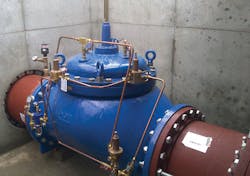Anti-Cav Control Valves Stop Cavitation Caused by Varying Summer, Winter Demand
The Hutchinson, Ks., Water Plant pumps its water from twenty wells into a reverse osmosis water treatment center for purification. It’s then mixed back with the well water, lowering the total dissolved solids in the water. The plant can handle 10 million gallons a day and provides water to 41,000 residents and businesses.
When the plant was built in 2008, it was designed primarily for the high summer water demand and not the low winter demand. The original mixing butterfly valves were sized correctly for the summer demands, but in the low winter demand, it would drop too much pressure across these valves. With inlet pressure varying from 90 to 50 psi and outlet pressure at approximately 10 psi, the butterfly valves had severe cavitation. The result was extreme noise and failing valves after just two years.
Cavitation is essentially rapid vaporization and condensation within a liquid. When local pressure falls to vapor pressure, vapor bubbles are formed. When these bubbles travel to an area of higher pressure, they collapse with phenomenal force and great localized stress. The shock waves and pressure fluctuations resulting from these high-velocity bubbles cause noise, vibrations, accelerated corrosion and limited valve flow.
Smaller mixing butterfly valves for the winter water demand were considered, but that would have involved piping modifications. The simplest, most reliable, cost-effective solution was a Pressure Reducing Valve (PRV) with Anti-Cavitation trim in front of the plant. In this case, the PRV would take the main pressure drop while the mixing butterfly valves would be used for trimming the flow.
After looking at all the flow options, Hutchinson decided to go with a 20” Singer Pressure Reducing Valve (S106-PR-AC) because it has a Single Rolling Diaphragm (SRD) that provides smooth, steady and precise pressure control from maximum to virtually zero flow. The effective area of a single rolling diaphragm remains constant so the bonnet is much smaller and lighter than a flat diaphragm. A measured quantity into the bonnet control chamber always gives the same smooth movement of the inner valve through the entire stroke. A smaller bonnet also makes the valve lighter and safer for maintenance, while the smaller control chamber enables it to respond faster to changing pressures. By eliminating the seat chatter at low flows (capable down to as low as 50 gpm), the SRD avoids injecting small pressure pulses into the piping, which, over time, may increase leakage, losses or pipe bursts.
Don Koci, superintendent of Hutchinson’s Water System, said, “Once the new PRV was put in place, the unbearable sound from cavitation was no longer present, and we now have consistent, reliable flow and pressure.” Going forward, the city should no longer have to incur the costs of replacing the valving on an annual or biannual basis.
Singer Valve is exhibiting at AWWA’s ACE16 expo in Booth 641.

